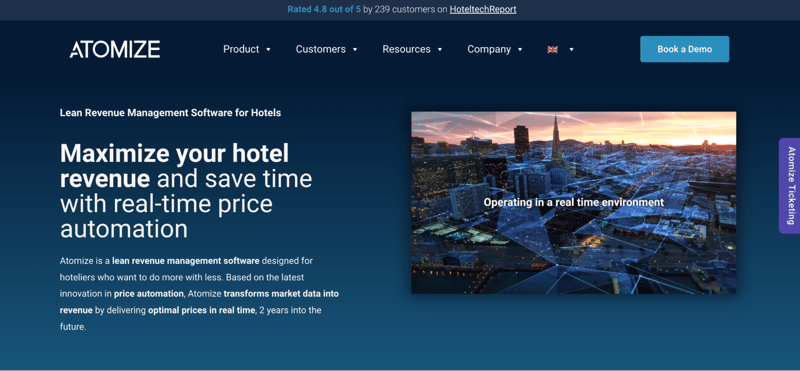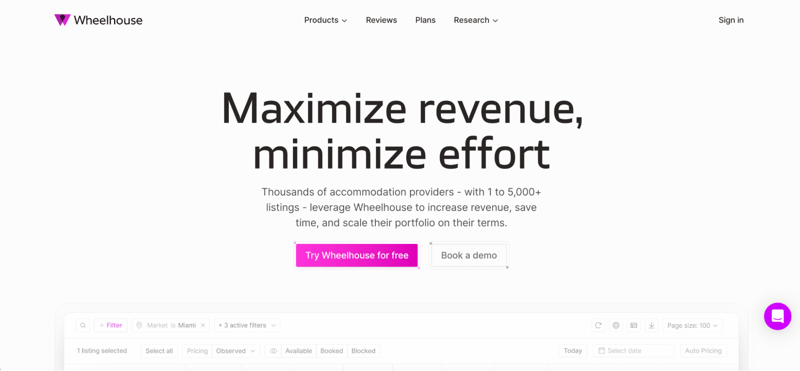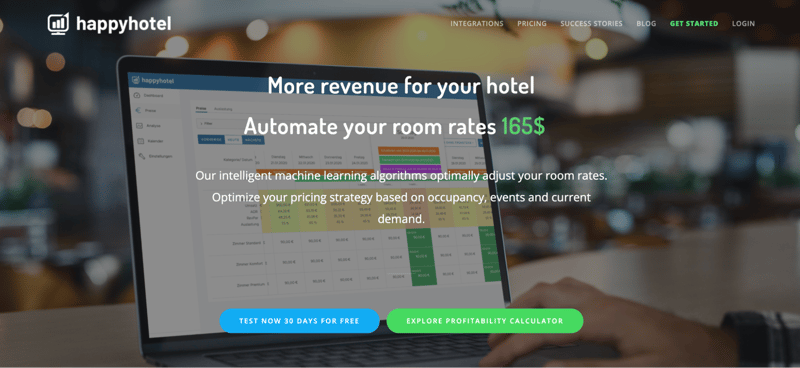What Goes Into an Effective Hotel Pricing Strategy for Boosting Revenue
Maximizing your hotel’s revenue in today’s Inclement economy is essential. With the speed of digital optimization,...

Table of Contents
Market fluctuations can happen instantly in the hospitality industry, affecting customer demand. These changes in demand can leave hotel revenue managers at a loss for how to keep up.
If you want your hotel to stay successful you must learn to adjust quickly to your clients' needs. For hotel revenue managers, implementing dynamic pricing strategies can help retain profitability, even during uncertain times.
In this guide, we go into detail about what dynamic pricing is and how it works. We’ll also talk about its features and benefits and help you look for the best dynamic pricing software you can use for your hotel.
Also commonly referred to as time-based or demand-based pricing, dynamic pricing involves fluctuations in a hotel’s room rates based on the travelers’ demands. During periods of low demand, hoteliers decrease their room rates to reach more target customers. On the contrary, higher travel demand means increasing room rates.
Higher travel demand is typically for two main reasons:
Hotel dynamic pricing software like HouseCount RMS takes these factors into consideration through historical and current data and provides real-time room rate updates based on specific hotel dynamic pricing algorithms. The following are examples of data that is considered in the dynamic pricing algorithm:
These external factors are essential to generate ways to boost profitability and maximize revenue.
Dynamic pricing strategies standard practice in the modern hospitality industry. Hotel revenue managers trust these strategies to keep track of real-time market trends and fluctuations and accurately respond to them. This allows hotel managers to have an easier time generating better room rates that positively impact the hotel’s overall revenue.
Artificial intelligence is an important emerging technology when it comes to hotel dynamic pricing strategies. Aside from the considerations mentioned above, AI can also consider a wide range of other aspects, including the following:
From there, AI can recognize patterns and trends and consider the context for how different types of data relate to each other. For instance, length of stay and guest booking patterns may be affected by seasonality and the frequency of events in the area.
Dynamic pricing in the hospitality industry also involves performing thorough market research, which AI helps with. By analyzing historical data and gleaning insights, hoteliers can make better, more educated business decisions and better forecast the probability of certain market changes.
The more detailed the historical data is, the better market fluctuations will be anticipated, resulting in improved strategies to increase the hotel’s RevPAR, ADR, and occupancy.
Dynamic pricing presents several benefits. For starters, it’s a revenue management strategy that can boost your hotel’s sales, maximizing your profits and increasing hotel revenue
The market research you perform to adjust the prices can also help you understand better your consumers’ behavior. Let’s go in-depth with the following benefits below.
Regardless of the type of hotel, your main business goal is always to boost your sales to maximize profits. This means decreasing the chances of a room remaining unsold for an extended period. Because dynamic prices implement rates based on current market fluctuations, you can guarantee that revenue managers can still boost sales, even during off-seasons.
Moreover, because you understand market trends, it’s easy to price your rooms at a rate that can meet the current market price. Or even better, you can change the rate to below the market price. This can increase the chances consumers will choose your property instead of your competition. The result? Increased occupancy, which in turn allows you to maximize profits.
Hoteliers can utilize dynamic pricing to decrease revenue loss. You can offer clients these rooms at lower rates, potentially maximizing profits and increasing daily revenue.
Potential customers expect to see prices reflecting market trends and that are competitive with other accommodations in the area. This makes them more likely to book at your hotel.
Moreover, relying on revenue management software can make demand forecasting easier. The software can study conversions, data reservations, group bookings, and cancellations to determine the best prices consumers are willing to pay. Moreover, dynamic prices can also attract price-sensitive customers.
Dynamic pricing strategies exist because customers are top priorities for hoteliers. You can also use the pricing system to understand customer behavior better. The hotel dynamic pricing algorithm makes tracking and studying different audience segmentation and room preferences easier to present with attractive room rates.
Hotel dynamic pricing also allows you to monitor how your customers are affected by seasonal peaks and special occasions.

Dynamic pricing in hotels relies on data. But not just any data. If you’re seeking strategies for dynamic pricing, you must consider the following data pipelines:
It’s always important to consider these factors because they serve as the blueprint for your dynamic pricing strategy. And without proper software, proper implementation of dynamic pricing in hotels is almost impossible given the wide range of factors to consider.
Without revenue management software, you will be unable to quickly glean insights and context from every data stream. This makes your dynamic pricing strategy less valuable and relevant.
The best solution to mitigate this relies on hotel revenue management software offering pricing intelligence engine functionality. It saves significant time by effortlessly generating the best dynamic pricing strategies based on data relationships.
Basically, you choose the software, install the system, integrate it with your hotel’s current tech tools, and rely on automation to get everything working.
HouseCount RMS uses an engineering fundamental called feedback theory, which analyzes cause-and-effect on a circuit or a loop. By recognizing how the context of different types of data can be affected by each other, HouseCount is able to provide transparent, flexible, and accurate pricing recommendations considering the full story in mind.
Before implementing effective dynamic pricing strategies, you must understand they are not risk-free.
Think of it like this: when your guests are used to booking the same flat room rates in your hotel for years, they may feel upset when they see increased prices. One way to avoid losing your customers because of this is by offering loyal customers special promotions.
You must also consider the public perception your hotel might receive from the sudden rate increase. Expect consumers to judge you for taking advantage of the higher room demands.
Plus, consider the expectations of your clients, especially when your room rates increase. This means your employees must always practice the best measures to give your guests outstanding services.
However, these are merely challenges you can overcome with the right hotel revenue manager, revenue management software, and outstanding business culture. Dynamic pricing can do more good than harm for your hotel, mainly because it reduces the workload on your team and ensures your rates remain competitive the entire year.
Moreover, you must also be smart in choosing the systems that will work for your business. When looking for an effective pricing intelligence tool, these are the two main things you must always consider:
Knowing the dynamic pricing in hotels and its benefits is only one part of the equation. You must also understand how it can improve your overall hotel revenue. Generally, because dynamic pricing aims to increase room occupancy by adjusting room rates, it also aims to increase your revenue.
How does dynamic pricing achieve this?
It diligently monitors past and current market trends and compares competitor pricing. Thus, this helps increase your revenue per available room or RevPAR to match your hotel’s room rates to the current market value.
Another way dynamic pricing can maximize your hotel revenue is through the “U” pricing strategy. This works by offering rooms at a lower price for a certain period before the booking date. Then, as the date grows near, you can quote higher prices because of the increased demand.
Dynamic pricing also allows you to increase your rates based on how much your guests are willing to pay. It’s a win-win situation, isn’t it? Guests are contented with the price they pay, and your hotel has maximized room occupancy.
Moreover, you can also manage the prices of your unsold rooms, decreasing the chances these rooms remain unsold, whatever the season. Always keep in mind that increased room occupancy potentially leads to better revenue.
Two types of dynamic pricing strategies exist for your hotel: fixed and dynamic. Fixed pricing refers to establishing a maintained price point for your room rates for prolonged periods. In contrast, dynamic pricing involves adjusting room rates based on specific market trends.
Knowing which strategy is more appropriate means understanding their differences and significant implications.
|
Fixed Pricing |
Dynamic Pricing |
|
Room rates are the same over a certain period of time |
Room rates fluctuate and are time-based |
|
Prices are not affected by trends, market fluctuations, occupancies, and demands. |
Prices change based on overall demand, occupancy, and other market trends |
|
Hotels know the market well and constantly monitor yearly trends. |
Focus more on area demand and supply, capturing more businesses. |
|
Can restrict increasing overall profit by the number of volumes sold |
More flexible in increasing your profits |
|
No direct interaction with data systems for accurate forecasting |
Automated systems can adjust room rates based on data forecasting |
Even when fixed pricing involves setting the same room rates for an extended period, it also has several advantages. For instance, it can attract more consumers because the exact room prices over time give them more assurance over time.
Another advantage of fixed pricing is consistency. There are fewer chances that the prices will fluctuate, allowing your customers to get used to how much your rates are. Plus, because the price points are fixed, generating profit estimates and sales forecasting is easier.
One downside of fixed pricing is the lack of flexibility to consider market trends and adjust room rates accordingly. This increases the risk of failing to achieve your expected profits for some time. Moreover, undercharging is easier because of the need for more data forecasting.
Lastly, fixed pricing also does not permit adjustments in selling off available seats or inventory in other types of entertainment events.
Why is fixed pricing still more common than dynamic pricing? The answer is simple. Hoteliers need more confidence in how they should position their room rates. They fear they might be charging too much, increasing the risk of losing their customers.
Fortunately, simple strategies exist to help hoteliers gain the confidence they need to utilize dynamic pricing. Let’s talk about these strategies below.
Generally, you can increase your rates when your hotel’s room occupancy increases because this may mean that your hotel rooms have better demands in the market than your competitors. And while we all know that spiking the rates is the best solution for increased demand, a measured approach is sometimes better.
What is a measured approach? Let’s take a look at an example:
Say your hotel has a 20% room occupancy today. Instead of spiking your rates by 40%, you might want to consider only increasing the prices by 20% to check whether your guests will continue booking your hotel.
When your hotel increases its occupancy to 50%, you can increase your room rates again by 10%. Over time, when the demand for hotel booking goes down, you can try decreasing your prices.
This simple approach can maximize your hotel bookings, allowing you to increase at a higher available rate than when you keep your rates fixed.
It’s common for hoteliers to prioritize peak seasons and busy nights, making them forget off-season or slower nights. Employing this approach lets you miss opportunities for guests to book longer stays. Why not give your pre and post-nights a boost?
Consider giving your guests flexible, longer stay options rather than one-nighters. Try implementing a MinLOS or minimum length of stay, such as three to four nights. Even when you offer these nights at a more affordable rate, you’re still increasing your overall room occupancy. The end result? A possible boost in your overall revenue.
Now that you have an overview of hotel dynamic pricing, effective strategies, and how they work, it’s time to identify your options when choosing hotel dynamic pricing software for your business.
Tools in dynamic pricing software can accomplish the following tasks:
There are a lot of possible choices in the market, but we have summarized our top three picks below.
|
Hotel Dynamic Pricing Software |
Best Features |
|
Atomize |
|
|
Wheelhouse |
|
|
Happyhotel |
|

Atomize is a popular revenue management system focusing on dynamic pricing for the vertical and hospitality industries. It prioritizes the essence of time by promoting convenience to drive hotel profitability.
Atomize ensures a better understanding of customer intent and behavior and offers the most effective rates according to guest demands. It also looks at forward-looking data through forecasting to predict rates that will benefit the hotel’s revenue.

Wheelhouse is another pricing intelligence tool, ideal for any type of hotel or property management. It includes customization capabilities, market insights, and monitoring of competition data.
Wheelhouse guarantees detailed and accurate market reports and versatile pricing engine tools. This software also lets you make better decisions about boosting your hotel’s efficiency and overall revenue.
Moreover, Wheelhouse also features an easy-to-navigate interface, ideal for beginners. Enter your portfolio details and let the software’s engine tool do its magic. Its customization capabilities and intuitive interface also allow you to determine risk tolerance and future predictions.

As a yield management and revenue system, Happyhotel focuses on utilizing hotel KPIs to generate effective hotel dynamic pricing strategies. It also uses cloud-based software, ideal for any hotel size.

HouseCountRMS is a unique revenue management system with an exceptional pricing intelligence engine tool for the perfect combination of customization and automation. It allows users to perform the following tasks:
HouseCountRMS offers real-time and dynamic pricing solutions with its cloud-based software. This ensures accuracy in adjusting room rates based on reliable market data and current trends. HouseCountRMS also generates the best measures to maximize your hotel’s revenue opportunities and overall user experience.
With solid pricing recommendations, HouseCountRMS ensures you are also tracking your competitors. This allows you to set prices that will make your guests loyal to your hotel. Its pricing features include the following:
In conclusion, dynamic pricing in the hotel industry is a strategy that involves adjusting room rates based on various factors such as demand, seasonality, competition, and customer behavior. It is a powerful tool that allows hotels to optimize revenue and maximize profitability.
Moreover, hotels must invest in robust data analytics and technology systems like HouseCountRMS to effectively implement dynamic pricing. Accurate and timely data collection, analysis, and forecasting are vital for making informed pricing decisions. Hotels should also regularly evaluate and adjust their pricing strategies based on market dynamics and customer feedback.
If you’re interested in implementing dynamic pricing in your own hotel, HouseCount RMS can help. Contact Luxe Pricing today to schedule a demo and learn more about how HouseCount RMS can allow you to create dynamic pricing strategies.




Get Hooked! Sign Up to get the latest catch sent to your inbox.
Maximizing your hotel’s revenue in today’s Inclement economy is essential. With the speed of digital optimization,...
Static pricing and seasonal room rates are no longer the frontrunners in maximizing revenue and boosting profitability...
Markets in the hotel industryconsistently fluctuate because of changes in supply and demand, usually because of...